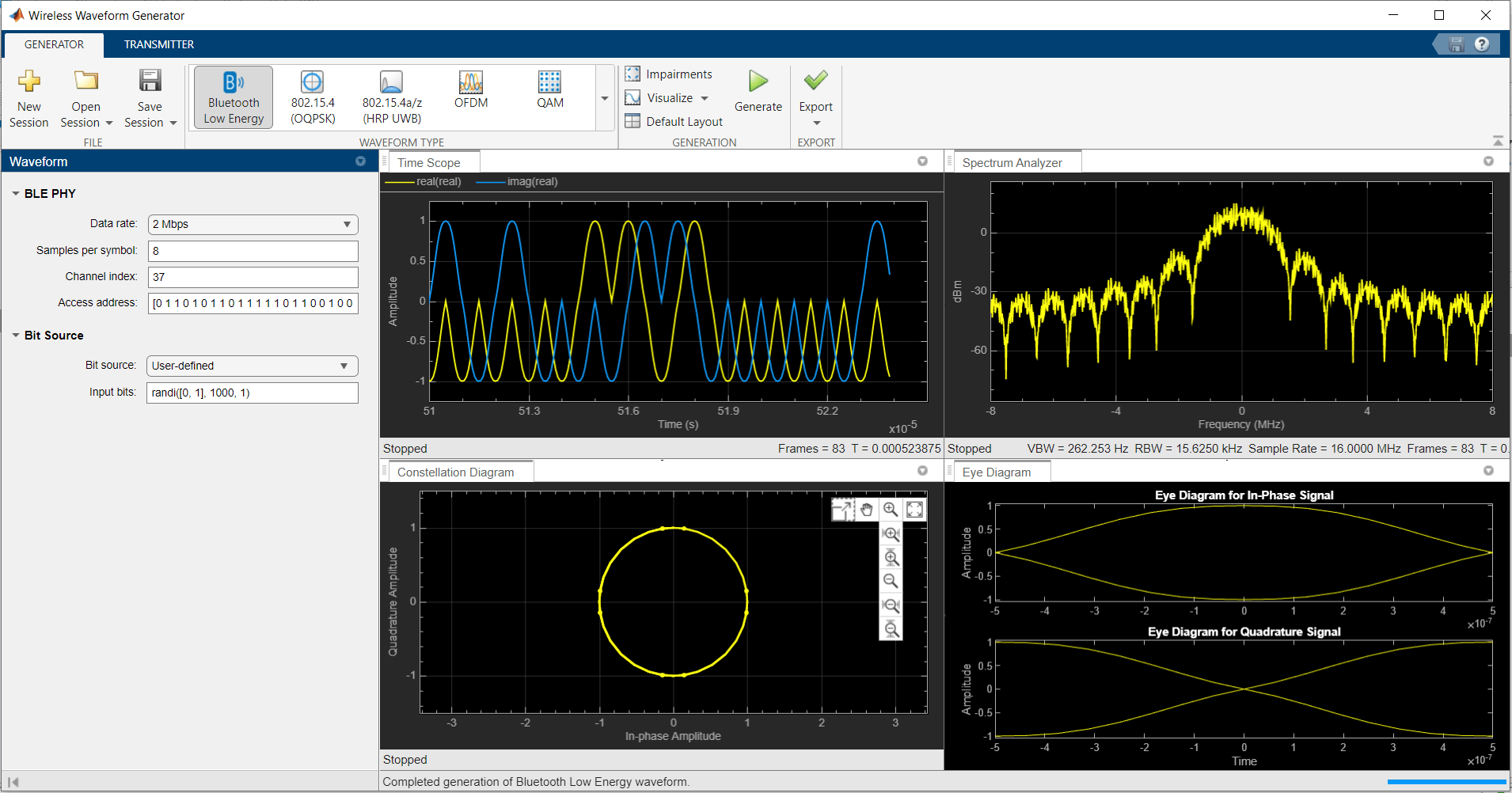Bluetooth LE Waveform Generator
Description
The Bluetooth Low Energy Waveform Generator app enables you to create, impair, visualize, and export modulated Bluetooth® low energy (LE) waveforms.
To use this app, you must configure the Wireless Waveform Generator app for Bluetooth LE waveform generation. Using this app, you can:
Generate Bluetooth LE waveforms with physical layer (PHY) data rate of 2 Mbps, 1 Mbps, 500 Kbps, or 125 Kbps.
Generate Bluetooth LE direction-finding waveforms specified in the Bluetooth Core Specifications 5.1 [2].
Configure, generate, and visualize Bluetooth LE radio frequency (RF) PHY transmitter and receiver test waveforms as specified in [4]. For information about the Bluetooth LE RF PHY tests that the app supports, see Overview of Bluetooth Test and Measurement.
Export the Bluetooth LE waveform to your workspace or to a .mat, .bb, or .txt file.
Export Bluetooth LE waveform generation parameters to a runnable MATLAB® script or a Simulink® block.
Use the exported script to generate your waveform, without the app, from the command line.
Use the exported block as a waveform source in a Simulink model. For more information, see the Waveform From Wireless Waveform Generator App block.
Visualize the Bluetooth LE waveform in the spectrum analyzer, time scope, constellation diagram, and eye diagram.
Distort the Bluetooth LE waveform by adding radio frequency (RF) impairments, such as additive white Gaussian noise (AWGN), phase offset, frequency offset, DC offset, in-phase and quadrature (IQ) imbalance, and memoryless cubic nonlinearity.
Generate a waveform that you can transmit using a connected radio or lab test instrument. The Transmitter tab shows the signal generator, radio transmitter, and SDR options available. Transmitter options include signal generator (Instrument or NI-VST), radio transmitter (USRP N3xx series and X series radios), software-defined radio (Pluto, USRP E/B/N/X, USRP E, Zynq Based).
To transmit a waveform by using a lab signal generator, you must have Instrument Control Toolbox. For more information, see Quick-Control RF Signal Generator Requirements (Instrument Control Toolbox). If you select Transmitter, the connected lab test instrument must:
Support the TCP/IP interface.
Use one of these drivers — AgRfSigGen, RsRfSigGen, AgRfSigGen_SCPI, or RsRfSigGen_SCPI.
Be supported by the
rfsiggen(Instrument Control Toolbox) function.
If you select NI-VST, the connected lab test instrument must:
Support the PXI interface NI-RFSG option when an NI VST resource is selected.
Use the NI-RFSG driver.
Be supported by the
rfsiggen(Instrument Control Toolbox) function.
To transmit a waveform by using an SDR, connect one of the supported SDRs (ADALM-Pluto, USRP™, USRP embedded series, or Xilinx® Zynq-based radios) to a computer with the associated add-on installed. For more information, see Transmit Using SDR.
To transmit your waveforms over the air at full radio device rates, use the Wireless Testbench™ software and connect a supported radio to your computer. For a list of radios that support full device rates, see Supported Radio Devices (Wireless Testbench). This feature requires Wireless Testbench. For an example, see Transmit App-Generated Wireless Waveform Using Radio Transmitters.
To create, impair, visualize, and export waveforms other than Bluetooth LE waveforms, you must reconfigure the app. For a full list of features, see the Wireless Waveform Generator app.
For more information about the Wireless Waveform Generator app, see Create Waveforms Using Wireless Waveform Generator App.
Open the Bluetooth LE Waveform Generator App
MATLAB Toolstrip: On the Apps tab, under Signal
Processing and Communications, click the app icon. ![]()
MATLAB Command Prompt: Enter wirelessWaveformGenerator. This
command opens the Wireless Waveform Generator app. To
configure the app for Bluetooth LE waveform generation, in the Waveform Type section,
select Bluetooth Low Energy.
Examples
References
[1] Bluetooth Technology Website. “Bluetooth Technology Website | The Official Website of Bluetooth Technology.” Accessed November 28, 2022. https://www.bluetooth.com/.
[2] Bluetooth Special Interest Group (SIG). "Bluetooth Core Specification." Version 5.1. https://www.bluetooth.com/.
[3] Bluetooth Special Interest Group (SIG). "Bluetooth Core Specification." Version 5.3. https://www.bluetooth.com/.
[4] Bluetooth Special Interest Group (SIG). "Radio Frequency Physical Layer (RF PHY)." "Bluetooth Core Specification." Version 5.3. Bluetooth Test Suite, RFPHY.TS.p20 edition 2. Revision date August 23, 2023https://www.bluetooth.com/.








